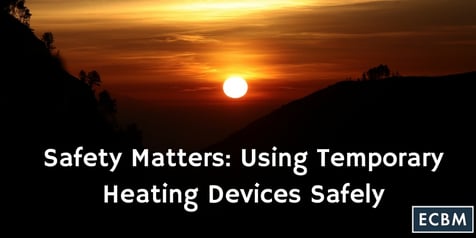
For some of us, the onset of cooler weather means heating our work area with temporary heaters. When used correctly, these heaters can make the working environment much more comfortable. However, when used incorrectly, they present a significant risk of fire or even explosion.
To-Dos Before Use
Heaters are primarily used seasonally and are often stored for long periods of time between uses. Prior to its use, inspect the equipment. It may be damaged from being hauled from one location to another. It is critical that each heater is examined for signs of damage before operation and is watched closely during initial operation to ensure that it functions properly.
Another safety precaution is to make sure the heater is approved for the environment in which you plan to use it. For example, is the unit approved for direct contact with wood floors? Does it consume oxygen? Does it radiate heat or force heated air across the room? The manufacturer’s specifications will explain how and where the heater may be safely used.
Finally, make certain there is adequate ventilation in the room in which the heater will be placed. When the natural supply of fresh air is inadequate, mechanical ventilation must be provided.
Before using a space heater or any type of temporary heating device, make sure it is approved for the environment in which you plan to use it.
Stay Safe While Keeping Warm
Job site heating devices get hot! Here are some things to keep in mind:
- Be aware that the outside of the heater may not look hot, but if you touch it, you could be severely burned.
- Heaters not intended by their manufacturer for use on wood floors must not be set on wood or other combustible materials. This type of heater must be set on suitable heat-insulating material such as one-inch concrete or masonry block. The insulating material must extend beyond the heater two feet or more in all directions.
- Temporary heaters must be placed at least 10 feet from combustible tarpaulins or similar coverings. Tarps must be securely fastened to prevent wind from blowing where they could upset the heater or be set on fire.
- Most temporary heating devices are intended to be used in the horizontal position; do not attempt to use them otherwise, unless permitted by the manufacturer.
- Each temporary heating unit must have a fire extinguisher with a rating of at least 20-ABC positioned to be immediately available in the event of a fire.
Be sure to get authorization to use any temporary heating device. Also, consider the job site’s conditions and requirements before selecting temporary heaters. It’s your job to become familiar with the safe use of a heating device.
|
